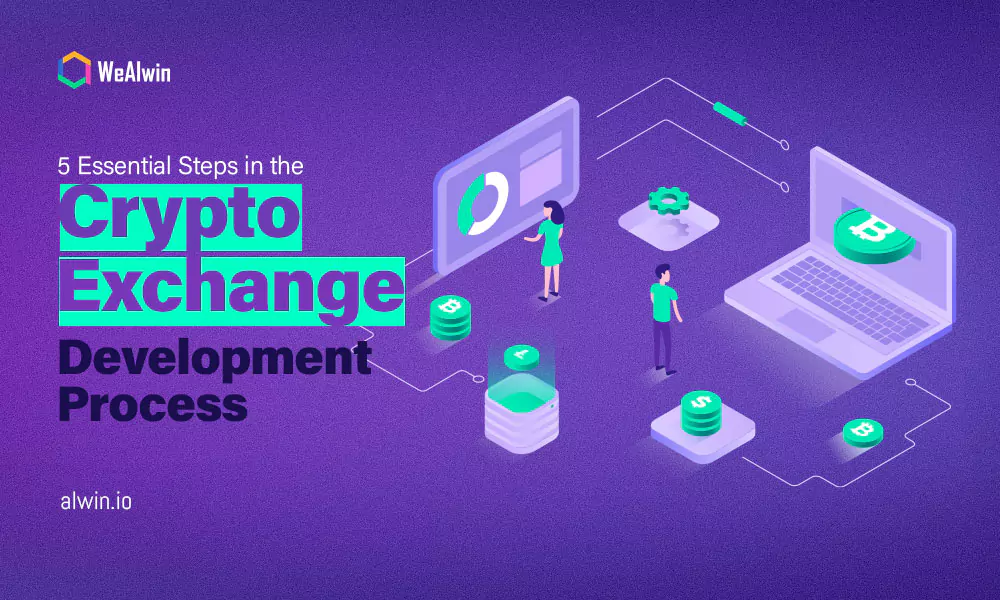
In crypto markets, traders buy, sell, and trade with lightning speed. Order-matching algorithms drive this process, swiftly pairing buyers and sellers at the best prices.
They're the powerhouse behind smooth and efficient trading, shaping the future of finance.
Have you ever wondered how crypto exchanges manage to match buyers with sellers lightning-fast?
Well, it's all thanks to a nifty tool called the cryptocurrency matching engine.
The Backbone of cryptocurrency exchange, ensuring trades happen smoothly and swiftly.
Let me break it down for you
What is an Order Matching Engine?
So, you're on a crypto exchange, ready to buy or sell some digital coins. The matching engine swoops in and scans through all the buy and sell orders in a flash.
Its mission? Pair up buyers with sellers faster than you can say " Bitcoin."

Efficient Trade Execution: This engine doesn't mess around. It sifts through order books like a pro, matching up buy and sell orders quicker than you can blink. Trades happen in milliseconds, so you won't be twiddling your thumbs waiting for your transaction to go through.
Access to Liquidity: Need access to bigger pools of liquidity? No problem. The matching engine links up traders from different order books, making it easier for you to trade directly with others. It's like having a VIP pass to the crypto party.
Algorithmic Magic: Behind the scenes, this engine is working its magic with algorithms. Whether it's FIFO (first-in, first-out) or prioritizing orders based on volume or price, it's got tricks up its sleeve to ensure orders are matched up just right.
Scalability: One size doesn't fit all in the world of crypto trading. That's why matching algorithms are customizable, catering to specific business needs and preferences. Flexibility is the name of the game.
Key Benefits of the Order Match Engine
Matching engines in the domain of cryptocurrency markets offer several advantages that cater to different needs and preferences.
Boosted Market Liquidity: Matching engines directly link up buyers and sellers, ramping up market liquidity and offering more trading opportunities. This surge in liquidity tends to lead to more precise pricing and an overall smoother trading journey.
Reduced Trading Costs: By cutting out middlemen like brokers and exchanges, matching engines slash trading expenses, making transactions more economical for traders like you.
Who doesn't like saving a bit of cash, right?
Heightened Security: Decentralized matching engines step up security measures by spreading out the process, making it tougher for hackers to target a single weak spot. This decentralized setup significantly strengthens transaction security, giving you peace of mind against potential fraudsters.
Stabilized Prices: Matching engines play a crucial role in stabilizing prices by connecting buyers and sellers across various exchanges. This makes it trickier for any individual to manipulate prices, fostering confidence in trading and ensuring a fair marketplace for everyone involved.
Drawing in New Users: Thanks to their knack for efficient order matching, matching engines offer a superior user experience that can attract fresh faces to exchanges. Streamlining the buying and selling process and ramping up overall trading volumes are big pluses that can help exchanges expand their user base. Who knows, you might just be one of those new users they reel in!
How Does Order Matching Work, Anyway?
So, you've placed your buy or sell order. Now what?

Order Placement: Traders like you put in their orders on the exchange, stating what they want to buy or sell.
Matching: The matching engine springs into action, scanning through all those orders to find the perfect match. It's like playing matchmaker for digital currencies.
Execution: Once a match is found, boom! The trade is executed, connecting buyers with sellers faster than you can say "crypto millionaire."
Spread Calculation: Now, here's where things get interesting. The difference between what the seller wants and what the buyer is offering (aka the spread) determines transaction fees. Have you got to pay the piper, right?
Transaction Completion: With the match made and fees sorted, the exchange seals the deal, making sure both parties walk away happy with their digital loot.
Consult with our business experts to develop your Own Crypto Exchange! Chat with us on WhatsApp
Types of Matching Engines
Alright, so when it comes to cryptocurrency exchanges, you've got two main types of matching engines they use: centralized and decentralized.
Let's start with the centralized one. This is like the big player in the game. Major exchanges rely on this type.
What it does is pretty straightforward: it matches orders from loads of users in real time.
Usually, it follows a first-come, first-served approach to matching orders, although some exchanges might have their twist on the algorithm. Now, these centralized engines are fast and efficient, which is great for quick trading.
But here's the catch – they're also a prime target for attacks because, well, they have a single point of failure.
On the flip side, we've got a decentralized matching engine.
It's like a network where everyone's on equal footing. No central server calling the shots here.
Instead, it's all about peer-to-peer action. So, orders from different users get matched up in real time without relying on any one central hub.
That means, even if one part of the network goes down, the whole system keeps chugging along. So, you've got more resilience against attacks compared to the centralized setup.
Order Matching Algorithms: Behind the Scenes
Core Concepts
Price-Time Priority (PTP) isn't just any order-matching algorithm; it's the method financial markets use to decide who gets their trades executed first.
Picture it like a line at the grocery store - the person who gets there first gets served. In PTP, it's all about who placed their buy order first and at the highest price.
Here's how it works: let's say there are two buy orders at $100 each, one for 50 shares and another for 100 shares. Along comes a sell order for 100 shares at $100.
PTP steps in and pairs up that sell order with the earlier buy order for 50 shares, leaving the bigger buy order untouched.
If another sell order for 50 shares at $100 comes in later, PTP matches it with the remaining 50 shares of the bigger buy order, making sure no orders are left hanging.
Now, on the other side of the coin, we've got Pro-Rata Matching. It's another way to match orders, but this time it's all about fairness based on order size, not who got there first.
So, imagine you've got a 200-share buy order and a 50-share buy order at the same price.
When a sell order for 200 shares comes along, Pro-Rata Matching divides it up proportionally - 160 shares go to the bigger buy order and 40 shares to the smaller one.
This system makes sure every order gets its fair share, no matter if it's big or small.
It's like divvying up a pizza so everyone gets a slice.
Pro-Rata Matching comes in handy when there are lots of orders at the same price, and the system needs to spread the trades around evenly.
While the core matching algorithms prioritize price and time (FIFO), there are additional factors that influence how orders get matched
Order Types
Market Orders: These are all about speed. A market buy order instructs the exchange to purchase a specific amount of cryptocurrency at the best available asking price.
Similarly, a market sell order aims to sell your crypto at the best available bid price. Market orders get matched quickly because the exchange prioritizes filling them immediately.
However, the downside is that you may not get the exact price you were hoping for, especially in volatile markets.
Limit Orders: These offer more control over price but may take longer to execute. With a limit buy order, you specify the minimum price you are willing to pay for a certain amount of cryptocurrency.
The order will only be filled if a sell order appears at your designated price or lower. Conversely, a limit sell order sets a maximum price at which you are willing to sell your crypto.
The order will only be matched if a buy order comes in at your price or higher. Limit orders can be a good option if you want to ensure a specific price or better, but be aware that your order might not be filled immediately, especially if your price doesn't align with the current market conditions.
Hidden Orders
These are more advanced tactics used by some traders, particularly in algorithmic trading.
Unlike standard orders that are fully visible on the order book, hidden orders only reveal a portion of the total order size.
This allows traders to strategically test the market without revealing their entire hand.
Here's why hidden orders are used
Minimize Market Impact: Large orders can significantly influence market prices. By hiding the full size of an order, traders can avoid causing price swings before the entire order is executed.
Algorithmic Trading Strategies: Some automated trading algorithms rely on placing and canceling orders rapidly based on market conditions. Hidden orders can help these algorithms operate more discreetly and avoid tipping their hands to other market participants.
Main Features of the Matching Engine
- Super Speed: Matches buy and sell orders in milliseconds, ensuring quick trade execution (think: latency of 1 second, processing time under 2 seconds).
- High Volume: Handles massive order streams (like processing 200,000 orders per second), keeping up with busy markets.
- Fair Play: Uses transparent algorithms to match orders based on price and time, giving everyone a shot.
- Order Flexibility: It supports different order types (market, limit) so you can choose how you trade.
- Always on Duty: Runs reliably and securely to avoid trade disruptions.
The Impact of Matching Algorithms
Market Efficiency and Liquidity
Order matching algorithms are pivotal in financial markets, shaping how trades are executed swiftly and how market liquidity flows. These algorithms form the backbone of order-matching engines, smoothly pairing buy and sell orders for efficient execution.
They ensure fairness and effectiveness in executing orders.
Now, picture yourself selecting a matching engine. It's a crucial decision. You've got to consider things like the types of assets it supports, the variety of order types available, and how quickly it can execute trades without delay.
Algorithmic trading is a whole other ball game. It's all about speed and precision.
Think microseconds or even nanoseconds. Traders use complex mathematical models like mean reversion strategies and volume-weighted average price (VWAP) strategies to make split-second decisions.
These strategies are like secret weapons, honed to perfection to make trades as efficient as possible. It's all about squeezing out every ounce of advantage in the market.
Then there are electronic trading systems. They're the wizards behind the curtain, making the market dance to their tune.
These systems automate the matching of orders, following rules like time-price priority and FIFO to ensure fairness and accuracy.
Let's not forget about transparency. These systems make everything crystal clear, reducing errors and speeding up trades.
Take the National Stock Exchange (NSE), for example. They use a price-time priority algorithm, meaning orders at the best price get priority based on when they were placed.
In a nutshell, order-matching algorithms and electronic trading systems are the unsung heroes of the financial world, ensuring everything runs smoothly and fairly, even in the blink of an eye.
Potential Issues and Fairness
In various fields, like assigning students to schools, matching users to advertisers, and connecting applicants to job interviews, we rely heavily on matching algorithms.
These algorithms play a crucial role in ensuring fairness, meaning everyone gets a fair shot based on their abilities and qualifications. But sometimes, fairness gets threatened by sneaky practices like latency arbitrage and frontrunning.
Now, what are these?
Latency arbitrage is taking advantage of tiny delays in information transmission to gain an edge, while frontrunning involves using secret info to get ahead in a deal.
To combat these issues, we need fair and transparent order execution. This means treating all orders equally, no matter when they come in or how big they are.
Transparency ensures everyone has the same info to make informed choices.
One way to make matching algorithms fairer is by using uncertainty-aware fairness notions.
Take for example the paper "Fairness in Matching under Uncertainty." It suggests a linear programming approach to distribute resources fairly, even when we're not entirely sure about certain factors.
This helps tackle uncertainty head-on, preventing it from skewing outcomes.
Another strategy is focusing on group fairness, like in the paper "Fairness Through Matching." Here, the algorithm learns to make fairer models that don't unfairly favor one subset or individual within a group over others.
The aim is to reduce inequalities between groups while keeping overall accuracy intact.
The Core Components of the Matching Engine
The Matching Engine comprises several key elements, which actively perform various functions:
Matching Algorithm: This core component prioritizes and executes orders based on predefined rules, determining order matches and their execution sequence.
Order Book: Market participants' buy and sell orders are recorded in the order book, containing information on their willingness to trade assets at specific prices and volumes. Market orders are fulfilled using limit orders stored in the order book.
Console UI: This application offers a user-friendly interface for monitoring and administering orders within the Matching Engine. It aids exchange administrators in overseeing and managing trading activities.
Market Data Feed: This service delivers real-time updates on trading information, including quotes, last traded prices, and volumes. It is commonly utilized in web-based trading systems and public websites to provide the latest market data.
FIX API and REST API: These APIs provide endpoints for trading, exchange management, historical data requests, and instrument management. They enable functionalities such as order placement, modification, cancellation, accessing historical data, and managing tradable instruments.
Some Features that could aid in Selecting the Best Matching Engine are
- Asset Classes
- Order Types
- Latency Considerations
- Throughput and Availability
- API Integrations
- Uptime
- User Interface
- Scalability
Conclusion
Matching engines are the silent powerhouses of crypto exchanges, operating with lightning-fast precision, akin to matchmakers for your trades. Employing FIFO and price-time priority algorithms, they excel at finding optimal matches, ensuring seamless and efficient transactions.
Continuously evolving to prioritize speed, accuracy, and dependability, these engines incorporate cutting-edge technologies such as AI and gaming tech behind the scenes. The future promises even more advanced algorithms, real-time matching capabilities, and dynamic order book updates – all aimed at enhancing liquidity and bolstering market stability.
For enthusiasts of technology, decentralized platforms are venturing into trustless order matching utilizing blockchain technology for heightened security and operational efficiency.
WeAlwin Technologies leads this charge towards a future where innovation and reliability converge to redefine the landscape of crypto exchange development.
For Further Discussion about Cryptocurrency Exchange Development Services
Contact us…


















